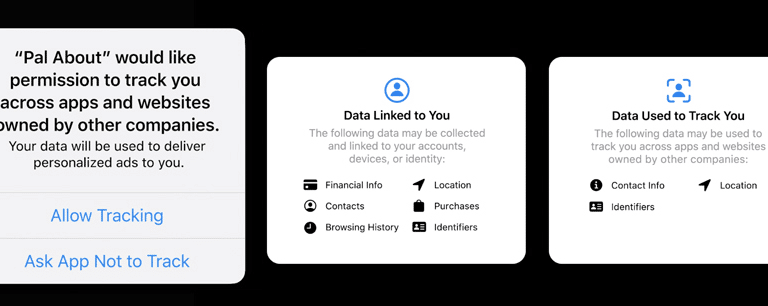Note: As of January 28th, 2021, Apple has changed its policies regarding attribution on iOS 14. Read about that update and Branch’s latest stance here.
Update: we have published a follow-up post: How To Prepare Your Mobile App and Attribution Stack for Apple’s iOS 14 Privacy and IDFA Changes
The world of app install attribution as we know it has come to an end. At WWDC in 2020, Apple announced that in iOS 14 (likely Sept/Oct this year), the IDFA is no longer a relevant or widely-used identifier. There are two changes that put the writing on the wall for this:
1. iOS 14 will default all devices to limit ad tracking enabled, which zeros out the IDFA
2. If the publisher app or destination (advertiser) app wants to read the IDFA, they must each separately receive permission from the user with the following prompts

I can’t imagine a single user that would ever agree to let themselves be “tracked around the internet”. There’s no way this will see anything but accidental adoption. Therefore, we must assume that IDFA is no longer usable. Even with the proposed SKAdNetwork replacement, this is a fundamental elimination of basic capabilities like user-level attribution, retargeting audiences, look-alike audiences and so much more.
What about Android? At least we still have GAID you might be saying. With Google’s recent announcement to remove 3rd party cookies from Chrome, the writing is on the wall for GAID to follow suit, especially with Apple setting the industry precedent.
Fortunately, Branch has been building the linking platform and matching technology designed specifically for the world where universal identifiers such as IDFA and GAID don’t exist. We’ve long believed that user privacy must be maintained by the service owners, since users often don’t take the time to read privacy policies and terms of use. We must be good data citizens, and “tracking users across the internet” contradicts that concept at its core.
The Branch system uses an industry-unique, anonymous, probabilistic algorithm that incorporates historical attributions to deliver high accuracy matching where there is no universal ID. This means where the rest of the industry is reliant on fingerprinting technology with accuracy rates of 60-70%, Branch can deliver superior, more accurate attributions. Today, our predictive matching engine already covers in the high 90s% of your mobile user base. We expect high coverage rates to continue in a world without IDFAs, providing you reliable and correct numbers where others fail. We will no longer be able to deliver deterministic matches on iOS without a user logged in across your properties, but are confident in this alternative approach. The best part is that all this is accomplished while no user data from your app is linked to other companies’ apps’ data. You can review this and more details on our privacy principles page.
Summarizing so far, we’re confident that Branch will continue to deliver its services and users will gain huge amounts of control over their data, so we see this as a massive win for the mobile ecosystem. That said, there will certainly be changes to the advertising measurement functionality within Branch, specifically when it comes to app-based measurement from install-focused paid campaigns.
We believe this to be ultimately pushing the industry towards the world that Branch has been promoting since inception: one where organizations can finally think about their campaigns more holistically, focusing on the user experience and full customer lifecycle rather than the unhealthy obsession with install ad tracking.
True customer value only begins at acquisition but is fully realized when you give them a great user experience, can re-engage them in a meaningful way, and can provide value seamlessly across platforms. Ultimately, companies will emerge stronger from this shift, and their users will greatly appreciate it.
What does the advertising measurement industry look like in a post-IDFA world? To be honest, there is still a lot of uncertainty, and we expect the specifics will evolve as iOS14 continues in development. The key unknown is the language that Branch will use to communicate with other ad networks to do validation. There are a few options moving forward to consider:
1. Apple has proposed usage of the SKAdNetwork framework, which completely anonymizes the attribution and eliminates user-level data. This will certainly break most marketing processes. There are also challenges in the actual implementation of this, requiring publisher apps to actively register the approved ad networks in a newly-released version of the app. We think it’ll be challenging for most to adopt and incorporate this technology.
2. Another alternative is the approach Google has taken on iOS search inventory earlier this year, where they internally model out the estimated number of conversions for a given campaign, only sharing aggregate numbers with advertisers. This also would restrict user-level data entirely, breaking most marketing processes.
3. The last and most likely outcome is the traditional tracking link methodology, which is widely used today outside of the self-attributing networks like Google and Facebook. Generally, the industry-standard method leverages IP-based fingerprinting to attribute in-app actions back to advertising clicks. This is the most tried and true method, since it has existed for some time, and we expect most will shift to this at least in the short term. This is an area of course where Branch’s accuracy is unparalleled.
The Branch team is working with Apple and the community to sort these details out with ad networks and partners, and we’ll be sharing more information as soon as it is available. We are starting with a webinar in partnership with Allison Schiff, AdExchanger’s Senior Editor for cross-device, measurement, privacy, and the app economy next Thursday, July 2nd at 10 am PT.
In the meantime, trust that you’re in the right hands and we’ll guide you every step of the way.






















